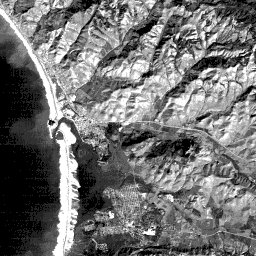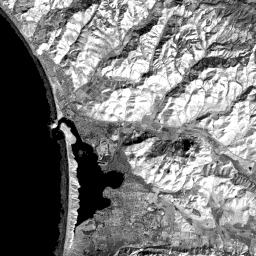



and, if you wish, compare each of these to bands 1 and 4. On the whole, superficially there seems to be little difference in tonal variations for features imaged in bands 1 through 3. The most perceptible change is a diminution in the extent of the ocean sediment patterns progressing from 1 through 3. The sun-facing slopes in the hill country seem a bit brighter in 3 than in the other two bands, perhaps influenced by the red component in light reflected from a surface underlain by brown soils and also by the brown color of the grass.
Because of the apparent similarities in tone for major features seen in the first 3 bands, one might wonder how their combination into a color composite, which we will inspect shortly, can lead to the dramatic color differences that actually result. The answer to this is subtle and rather complex but this is the essential reason: When images for the individual bands are generated, they are adjusted to have appropriate contrasts. The images produced have similar tonal variations for the ground classes because most such features have approximately the same relative differences in reflectance in each band. But, their actual reflectance values (partially embodied in their DN's or digital numbers [see introductory section for more details] ) will vary more from one band to the next. Thus, a green reflector may have a higher average DN value in band 2 than in 1 or 3 and that will contribute more effective brightness to the green component of a color composite.
 Now, we will finish our look at the black and white renditions
of the individual bands by displaying TM band 5. This band, centered
around 1.65 µm, most closely resembles band 7 but by flipping
back and forth into 7 and 5 you should be able to pinpoint several moderate differences.
In the beachbar (c), band 5 shows a moderately darker tonal variation, with some
"structure" in the patterns within the sand other than that caused
by vegetation. As with 7, the breakers have lost most of their
reflectance output and appear therefore as mottled medium-dark
grays. The mystery feature (s) has good internal contrast highlighting the distinctive patterns
that give its identity away (to the imaginative). The urban areas
"structure", defined by the criss-crossing street pattern, (within
towns labeled in yellow on the overlay map) is rather washed out
in the band 5 version. The two rows of bright dots representing
storage tanks near the power plant (t) almost disappear in 5 (and 7).
Now, we will finish our look at the black and white renditions
of the individual bands by displaying TM band 5. This band, centered
around 1.65 µm, most closely resembles band 7 but by flipping
back and forth into 7 and 5 you should be able to pinpoint several moderate differences.
In the beachbar (c), band 5 shows a moderately darker tonal variation, with some
"structure" in the patterns within the sand other than that caused
by vegetation. As with 7, the breakers have lost most of their
reflectance output and appear therefore as mottled medium-dark
grays. The mystery feature (s) has good internal contrast highlighting the distinctive patterns
that give its identity away (to the imaginative). The urban areas
"structure", defined by the criss-crossing street pattern, (within
towns labeled in yellow on the overlay map) is rather washed out
in the band 5 version. The two rows of bright dots representing
storage tanks near the power plant (t) almost disappear in 5 (and 7).
Code 935, Goddard Space Flight Center, NASA
Written by: Nicholas M. Short, Sr. email: nmshort@epix.net
and
Jon Robinson email: Jon.W.Robinson.1@gsfc.nasa.gov
Webmaster: Bill Dickinson Jr. email: rstwebmaster@gsti.com
Web Production: Christiane Robinson, Terri Ho and Nannette Fekete
Updated: 1999.03.15.